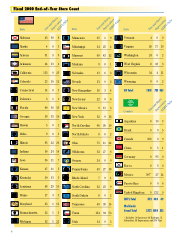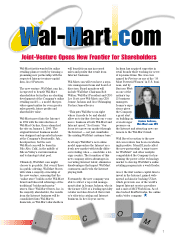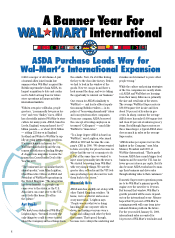Walmart 2000 Annual Report Download - page 17
Download and view the complete annual report
Please find page 17 of the 2000 Walmart annual report below. You can navigate through the pages in the report by either clicking on the pages listed below, or by using the keyword search tool below to find specific information within the annual report.
Sometimes, the best way
for Wal-Mart to fill a
value gap is to buy an
existing brand — often a
line recently abandoned
by a manufacturer. For
example, in the summer
of 1999 Wal-Mart started
selling diapers and toilet
tissue under the White
Cloud®label, a former
brand of Procter &
Gamble Co. Wal-Mart
used the same strategy
in the blue-jeans catego-
ry by buying the Faded
Glory®brand.
“Part of our philosophy on opening
prices is that they aren’t always the
cheapest prices on a type of item, as
with a cordless phone, for example,”
Connolly says. “It, might, instead, be
the best price on the most impor-
tant part of the category, such as
900-MHz cordless phones.”
This premium-value concept has
been the foundation of the Sam’s
American Choice®brand. Every
item in the Sam’s American Choice
line is tested to ensure that it is at
least equal to the national brands.
And in many cases, they’re
better. The percentage of
actual fruit juice in Sam’s
American Choice fruit
drinks, for example, is higher
than that of the national brands,
and there are more raisins in the
Sam’s American Choice raisin
bran than in any of the national
brand cereals. All Sam’s American
Choice products are grown, pro-
duced and manufactured in the
United States. In fact, the tea offered
by Sam’s American Choice is the
only tea still grown and produced at
a tea plantation in the United States.
Private-label brands are helping
Wal-Mart succeed in the extremely
competitive grocery business,
where consumers have learned to
accept — and even expect —
“store brands” as a cost-cutting
alternative. The private brands are
expected to prove particularly
useful at our smaller Neighborhood
MarketSM stores.
One of Wal-Mart’s recent ventures
into private-label branding was the
launch of a new line of laundry
detergents under the Sam’s
American Choice
name.
The new detergents can be
purchased in either liquid
or powdered form, and are
sold at the high end of the
opening price point in the
detergent category.
The Company grabbed
even more attention last
year for introducing its own
line of disposable alkaline
batteries marketed under
the name EverActiveTM.
Wal-Mart also has a popu-
lar line of automotive bat-
teries called EverStart®. The prod-
uct launch was backed by an
aggressive television advertising
campaign centered on sports pro-
gramming. So far, EverStart appears
to be catching on; the batteries
already are being installed as stan-
dard equipment in all Ranger boats.
SAM’S Club also has a line of
private-label products sold under
the Member’s Mark™ label. The
brand was created in 1997 and
focuses on providing premium prod-
ucts at exceptional values to SAM’S
Club members. Items in the line
include blue jeans, vitamins, dish-
washing detergent and many other
consumable products.
“One of the long-term benefits of
Wal-Mart’s private-label expansion
is that it could create strong global
brands,” Connolly says. Wal-Mart
Germany, for instance, recently
moved to crank up its private-
label offerings from 32 items
to about 1,000. Ol’ Roy®is
among the brands already
sold there, along with
Special Kitty®cat food and
Great Value®orange juice,
iced tea and tissues.
⋆
“We don’t create private-
label brands to improve our
profit margins; we create
them to improve value to
customers, which builds
customer loyalty.”
— Bob Connolly
15

















